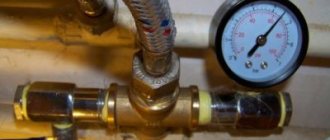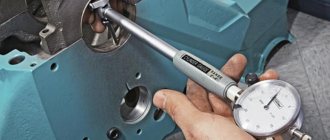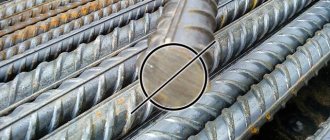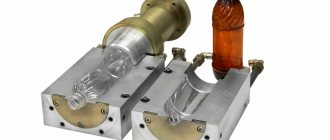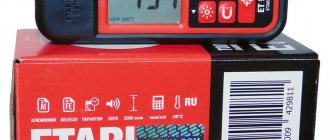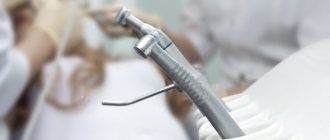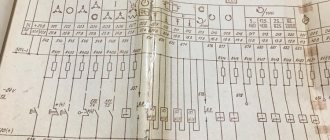Capillary-type viscometers are used to determine the viscosity of materials that have a relatively small value: meat and bone broth, blood and rendered fat, sunflower and soy miscellas, soap solutions, almond and peanut butters, confectionery fat. Capillary viscometers do not have the disadvantage inherent in rotational viscometers: in the capillary, the newly entering liquid is continuously sheared, and heat is carried away with the material, whereas in rotational viscometers the same test material is in the gap of the viscometer during the entire experiment. The theory of capillary viscometers was developed somewhat later than the theory of rotational viscometers.
At one time, the applicability of capillary viscometers for determining the rheological properties of materials under shear was denied, because in the capillary a non-uniform or less uniform shift of the material occurs than in rotational viscometers.
In capillary viscometers, they are set either by a constant flow rate of the liquid under study in all experiments, or by a constant pressure drop in the capillaries. In constant-flow viscometers, the pressure difference between the ends of the capillary is measured; in a constant-pressure device, the flow of material is measured.
Each viscometer consists of the following parts: a container for the material being tested, a calibrated capillary, devices for determining and regulating pressure, determining the flow rate (or outflow) of the material, and determining temperature.
The principle of operation of capillary viscometers is based on a continuous shift in the capillary of the newly entering liquid and the constant entrainment of the released heat with the material. Capillary viscometers have capillary sizes from 0.3 to 0.7 mm, which allows viscosity to be measured over a wide range. When choosing a viscometer, it should be kept in mind that the liquid flow time should be from 1 to 3 minutes. Otherwise, the accuracy of viscosity determination will be low.
Capillary viscometers can be divided into three groups:
W cylinder – piston
W flow devices, constant and variable level
The first group of devices includes the simplest viscometers, which are U-shaped tubes, in one of the elbows of which a capillary is placed (VPZh-1, Ubbelohde, Ostwald viscometer). In the Ubbelohde viscometer, shown in Figure 6a, for liquid to flow out, it is necessary to forcefully create pressure or vacuum in one of the elbows. The capillary in the device is located vertically, which presents certain difficulties when working with liquids with significant viscosity and surface tension. Next, the tubes are connected to the atmosphere, and the time of flow of liquid from the reservoir through the capillary into the reservoir is determined. The outflow time is counted when the liquid level in the tube with reservoirs decreases from mark m1 to m2. Knowing the flow time of the liquid, the measured viscosity is found.
a – Ubellode; b – Ostwald; 1 – container for measuring quantity
liquid flowing through the capillary; 2 – capillary; 3 – collection container
Figure 5 – Capillary viscometers
Capillary viscometers VPZh (Ubbelohde type) make it possible to determine the kinematic viscosity of a liquid in the range from 0.6 to 104 mm 2 /s at a temperature not exceeding 100 °C. Measuring viscosity comes down to determining the time of flow through a capillary of a given diameter of a certain amount of liquid from the measuring tank.
In the Ostwald viscometer (Figure 6b), the flow of liquid from one elbow to another occurs under the influence of hydrostatic pressure from a container with marks (m1 - m2) the test material flows through the capillary. When working on an Ostwald viscometer, select such a volume of the test liquid so that after filling the left knee to the upper mark, a meniscus of liquid barely protrudes in the lower part of the right container. The device is placed in a thermostat and secured vertically. The liquid is thermostatically controlled for 20 -25 minutes, after which, using a rubber tube, it is sucked into the left knee to such a position that the meniscus is 2 - 3 mm above the top mark, and the liquid is allowed to flow freely through the capillary. When the meniscus is at the level of the mark, turn on the stopwatch and measure the time of passage of the liquid between the marks. Viscosity on Ubbelohde and Ostwald instruments is usually determined in relation to the known viscosity of a standard liquid (water, castor oil, glycerin). The viscosities of two liquids measured under equal conditions in the same capillary will be related as
where η, η – viscosity, respectively, of the standard and test liquid, Pa s; ρ, ρ – density of the standard and test liquid, respectively, kg/m3; τ, τ – flow time of the standard and test liquid, respectively, s from level m1 to level m2.
Figure 6 – Capillary glass viscometers
Using the Ostwald-Fenske viscometer (Figure 6c), you can determine viscosity in the range from 1 to 8000 mm 2 /s by finding the time of movement of the material from level m1 to level m2.
The Canon-Fenske viscometer (Figure 6d) is used to determine the viscosity of opaque materials. It has a set of eleven capillaries with a diameter of 0.3 to 4 mm, which makes it possible to determine the shear rate in the range from 1 to 20,000 s -1, kinematic viscosity in the range from 0.6 to 10,000 mm 2 /s. The test consists of determining the time of movement of the material from container 1 through capillary 2, first to level m1; and then to m2 and m3. The capillary constants are different for containers 3 and 4, which must be taken into account when calculating the viscosity. In laboratory practice, glass viscometers of many authors are used, and in all devices the material moves either under the influence of its own mass or under the influence of an external vacuum. Common to all devices of this type is the presence of a capillary, a device for measuring the flow or volume of liquid and a system that creates hydrostatic pressure. A tube with a diameter from fractions of a millimeter to 2 - 3 mm can be used as a capillary to measure the viscosity of Newtonian and low-viscosity non-Newtonian liquids. The results obtained are, as a rule, invariant, i.e. do not depend on the diameter of the tube. For higher viscosity non-Newtonian fluids and viscoplastic systems, the diameter can reach 10 mm or more, and the measurement results are often dependent on the diameter, i.e. are non-invariant. Thermostating of the test liquid in the devices takes 10–3 minutes, which is determined by its volume. During this time, the temperature of the liquid in the device reaches the temperature of the liquid in the thermostat and the structure is restored, i.e. conditions are created identical to the previous measurement. During short-term thermostatting, temperature errors produce significant deviations of the viscosity measurement results from its true values. The use of excess pressure when liquid flows through a capillary creates the possibility of turbulization of the flow, therefore it is necessary to check for laminarity using the Reynolds criterion.
Read also: Polishing on a lathe
Viscometers VPZh-1, VPZh-2 and VPZh-4 are recommended for assessing the quality of gelatin by its viscosity. Measurements should be carried out at a temperature of 40 °C and a concentration of 10%. The VPZh-1 device allows you to determine the viscosity of molasses and molasses solutions when the temperature changes from 20 to 120 ° C and the concentration of dry substances from 7 to 79%. Using an Ostwald viscometer, the dependence of viscosity on temperature was studied for meat and bone broth and technical defibrated blood, grape juice, as well as the viscosity of aqueous-alcohol and aqueous-alcohol-sugar solutions. In the temperature range of 40 – 95 °C, the dependence of the viscosity of meat and bone broth on temperature is described by a power equation. As the temperature increases and the concentration of solids decreases, the viscosity of the broth decreases. For example, at a concentration of 16%, the viscosity is 6.67 10-3 Pa s, and at 90 °C – 2.69 10-3 Pa s. The viscosity of rendered beef fat at a temperature of 50 °C is equal to 29 10-3 Pa s, and at 90 °C – 10 10-3 Pa s, the viscosity of fish oil is respectively 11.5 10-3 and 3.7 ·10-3 Pa·s.
The second group includes devices in which the flow of material occurs due to hydraulic, pneumatic or mechanical movement of the piston in the cylinder. (Viscometer type Arveson, Azarova, etc.).
Such viscometers can be used to study both Newtonian and non-Newtonian materials.
An Arveson type viscometer with a hydraulic drive (Figure 7a) consists of a cylinder 5, a piston 3, the movement of which occurs from the injected liquid 2. The gear pump 7 is driven by an electric motor 8. The pressure in the hydraulic system is controlled by a pressure gauge 1. The mass under study 4 is driven by a piston 3 is pressed through capillary 6, while the pressure and speed of extrusion are measured. The viscometer has 8 replaceable stainless steel capillaries. At a shear rate of 10 s -1, viscosity can be determined in the range from 2.5 to 104 Pa s, and at a rate of 1.5 10 -4 s - from 0.1 to 10 Pa s. Viscometer B.M. Azarova is designed to study the rheological properties of high-viscosity dough and candy masses. It consists (Figure 7b) of a frame, a hydraulic power drive system 1, a working cylinder 2 with a jacket 3 for thermostatic fluid, and a block of electrical strain gauge equipment. The hydraulic drive consists of a high-pressure pump, an oil tank, a hydraulic power cylinder, two throttle valves and a pressure gauge. The working cylinder 2 with a bottom 5 is equipped with a piston 6 and a capillary 4. The cylinder, the bottom and the capillary have water jackets 3 connected to a thermostat. Electrical strain gauge equipment consists of a pressure sensor built into the bottom of the cylinder, a temperature sensor installed in the capillary channel, an amplifier and an oscilloscope. The material consumption is determined using a cutting mechanism, which consists of two solenoid electromagnets, on the cores of which a special knife-string is attached, suspended under the capillary cut.
Figure 7 – Viscometers with hydraulic drive.
An important advantage of capillary viscometry is the ability to simulate real technological processes, therefore these methods are widely used in the study of extrusion molding, transportation through channels of various lengths and shapes, as well as determining the dependence of the rheological characteristics of products on technological factors.
The third group is variable level or free flow viscometers, devices whose operating principle is based on the flow of material under the influence of its own mass. The main unit is a container with a capillary tube located below. The fluid flow rate is maintained constant, and its level varies in proportion to the viscosity. By measuring the height of the level, the value of the viscosity being studied is found. One of the variable level devices is the Leib viscometer, which consists of two vessels located one below the other. The liquid enters the upper vessel and flows through the capillary into the lower one with a longer capillary. A steady state is established at a certain hydrostatic column of liquid in the lower vessel. The height of this column is used to judge the viscosity of a given liquid.
Constant level viscometers
(the figure is based on observation of the nature of the liquid stream flowing from the capillary, by which the value of viscosity is judged. At a certain distance from the capillary nozzle 1, the jet is fragmented, and the lower the viscosity of the liquid, the shorter the distance to the crushing point. The tracking device in in the form of a carriage with photocell 3 is moved along tube 2. When the photocell passes the crushing point in the circuit, the photocurrent changes, which is recorded by a secondary device.
is based on observation of the nature of the liquid stream flowing from the capillary, by which the value of viscosity is judged. At a certain distance from the capillary nozzle 1, the jet is fragmented, and the lower the viscosity of the liquid, the shorter the distance to the crushing point. The tracking device in in the form of a carriage with photocell 3 is moved along tube 2. When the photocell passes the crushing point in the circuit, the photocurrent changes, which is recorded by a secondary device.
Read also: What are sexually transmitted diseases
Figure 8 – Constant level viscometer
In conclusion, we will consider the three simplest capillary flow viscometers - Engler, Redwood and Ford, which, although they do not have a theoretical basis, are often used in industrial technical laboratories. Significant disadvantages of the devices include a short working capillary, variable hydrostatic pressure, inaccurate distribution of thermostatting liquid, etc. Therefore, they are not recommended for use in scientific research.
The Engler viscometer is designed to determine the relative flow time of liquids, i.e. to determine viscosity in degrees Engler. Figure 9 shows a diagram of such a viscometer, brand OV-108 (VNR). Reservoir 5 is filled with the test liquid up to level indicator 7 (about 200 cm3). After removing stick 2, the liquid flows out through tube 9. In this case, the flow time τliq is determined. A control experiment is carried out using the same amount of distilled water and determining the time of its flow τl.). Viscosity in degrees Engler is determined by the ratio
τzh. – determined time of flow of 200 ml of test liquid, s;
τzh. – time of flow of the same volume of distilled water at 20 °C.
The temperature of the thermostatting liquid in vessel 6 is maintained by a heater 5 built into the bottom of the water bath and is regulated by a thyristor controller. To equalize the temperature, there is a stirrer 10 with handle 1. The temperature is measured by thermometers 3 and 4. The drain tube has a length of 20 mm, an upper diameter of 2.9 mm and a lower diameter of 2.8 mm. Heater power 400 W. The device is quite widely used to measure the viscosity of various liquids in industrial conditions. To convert viscosity in Engler degrees to units of dynamic viscosity, there are various empirical formulas in the literature, for example
where η – dynamic viscosity, Pa s; °E – viscosity in degrees Engler; ρ – liquid density, kg/m3.
Figure 9 – Engler viscometer
The Engler viscometer was used for low-viscosity food products: meat and bone broths, gelatin solutions, dairy products, etc. According to A.A. Sokolov, the viscosity of a standard glue solution (17.75% dry matter) at 30 °C ranges from 1.8 to 6 °E (from 0.01 to 0.045 Pa s). The viscosity of meat and bone broth under the same conditions is 2.1 °E (about 0.013 Pa s). Solutions of gelatin of the same concentration at 40 °C have a viscosity from 15 to 40 °E (from 0.11 to 0.3 Pa s).
Table 12 – Types of errors in capillary rheometry
| No. | Type of error | Cause of occurrence | Remedy |
| Systematic significant deviation of results from known data | inaccurate measurement of capillary dimensions, deviation of its shape from an ideal cylinder | capillary replacement; measuring dimensions using a microscope; calibration based on reference liquid | |
| flow turbulization | decrease in hydrostatic head or decrease in capillary diameter | ||
| Different expiration times in successive measurements | inconsistency of pressure at the entrance to the capillary | eliminating air or fluid leaks that create hydrostatic pressure; increasing the volume of the receiver; piston grinding; elimination of inclusions that impede the uniform movement of the piston | |
| thermostat temperature fluctuation | thermostat adjustment | ||
| change in the working volume of liquid in glass viscometers | using one pipette | ||
| incomplete emptying of the tank | taking into account surface tension; creating conditions that prevent the formation of a layer of varying thickness on the walls of the working measuring tank | ||
| ingress of particles that reduce the open cross-section of the capillary | *) liquid filtration | ||
| reduction in the size of the active cross-section of the capillary due to adhesion (adsorption) on its surface of any phase of the measured system | **) washing, cleaning and drying the capillary | ||
| Unsteady motion | at the initial section of the capillary, the diagram of velocities and velocity gradients differs from the theoretical one | reducing the relative influence of the initial section (lн) by reducing the diameter and average speed and increasing the length of the capillary; fulfillment of the condition lн ≥ 0.03 d Re, more precisely lн ≥ φ(n) d Re, where φ(n) is a function of the flow index. When its values are 0; 0.285; 0.5; 1.0; 1.5 it is equal to 0, respectively; 0.02; 0.033; 0.0575; 0.071 | |
| Thermal effect | conversion of pressure energy into thermal energy in highly viscous non-Newtonian fluids at high shear stresses | reducing pressure and velocity gradient by increasing the capillary diameter (for example, animal fats in a paste-like state) | |
| Loss of kinetic energy | reduction in pressure due to the kinetic energy of the escaping jet | decrease in flow rate; increasing the length and decreasing the diameter of the capillary | |
| Wall effect | slipping along the capillary wall (coarsely dispersed, multiphase systems) | corrugation of the inner surface; taking into account the phenomenon by special experiments | |
| Input effect | pressure loss in the local resistance of a cylinder-piston type viscometer | installing a pressure sensor on the capillary itself at a distance lн‹l | |
| Non-stationary effect | changes that occur in the system (while moving along the capillary) due to thixotropy (rheopexy), volumetric compression, phase separation, which can lead to a variable pressure gradient along the length of the capillary | decrease in length, increase in capillary diameter; special methods for processing rheometry results | |
| *) | The use of paper and similar filters that can adsorb any component from the solution is unacceptable; Metal sieves and glass filters are used for filtration. | ||
| **) | Ether, if stored for a long time, may leave an oily residue. |
Didn't find what you were looking for? Use the search:
Best sayings:
A student is a person who constantly postpones the inevitable.
10178 – | 7215 – or read all.
Viscometer
(from Latin viscosus - viscous) - a device for determining the dynamic or kinematic viscosity of a substance. In the CGS and SI units, dynamic viscosity is measured in poises (P) and pascal seconds (Pa s), respectively, and kinematic viscosity is measured in Stokes (St) and square meters per second (m²/s), respectively.
Read also: Rewinding electric motors as a business
Where are viscometers used?
Viscometers are used to control the viscosity of various substances involved in technological processes in many industries:
- in medicine, devices are used to measure the viscosity of human blood;
- in pharmacology and cosmetology - determining the condition of medications, creams, ointments and syrups;
- in the food industry - analysis of drinks, dairy products, honey;
- in chemical production - determination of the viscosity of liquid and flowing materials;
- in construction - production of paints and varnishes, putties, adhesives, pastes.
We constantly have to resort to regular analysis of the viscosity of oil and its refined products in the oil industry.
Viscosity analyzers are needed almost everywhere where work is carried out with liquid flowing materials, the condition of which must meet certain standards.
Types of paints
The operating principle of the spray gun allows it to spray absolutely any flowing materials. Today, there are dozens of paint manufacturers on the market with thousands of different mixture options. It is impractical to analyze each product separately, but we will tell you about the 5 main groups from which all possible derivatives come.
Alkyd enamels
. They are created on the basis of varnish mixed with various solvents, fillers and color pigments. Widely used to coat wood, metal and even concrete. White spirit is often used as a thinner for alkyd enamel.
Types of viscosity. How to determine
Viscosity is the ability of substances to resist their own flow due to the forces of molecular interaction.
There are two types of viscosity:
| Dynamic viscosity. | This is an indicator of density in real conditions, at an ambient and analyte temperature of 18-22 °C. The indicator increases with increasing pressure and decreases with increasing liquid temperature. Measurements are made in SI (International System of Units) units in Pa s (pascal second). |
| Kinematic viscosity. | The measurement is carried out at a certain pressure and temperature. The kinematic viscosity indicator corresponds to the ratio of the dynamic viscosity coefficient to the density of liquids or gases and is measured in Stokes (St), or square meters per second (m2/s). |
Viscosity can be measured either by hydrostatic pressure or by artificially created external pressure.
Table 1. Viscosity of liquids at a temperature of 20°C.
| In-in | Dynamic viscosity 10 -3 kg/(m s ) | Kinematic viscosity 10 -6 kg/(m 2 s -1 ) |
| Water | 1,34 | 1,22 |
| Glycerol | 1400 | 1170 |
| Transformer oil | 31,6 | 36,49 |
| Olive oil | 84 | 92 |
| Mercury | 1,59 | 0,114 |
| Ethanol | 1,23 | 1,52 |
| Acetone | 0,337 | 0,42 |
Capillary viscometry method
The capillary viscometry method is based on Poiseuille’s law of a viscous liquid, which describes the patterns of fluid movement in a capillary.
Let us present the equation of hydrodynamics for a stationary fluid flow, with viscosity η, through the capillary of a viscometer:
Q – amount of liquid flowing through the capillary of the capillary viscometer per unit time, m3/s, R – radius of the viscometer capillary, m L – length of the capillary viscometer capillary, m η – liquid viscosity, Pa•s, p – pressure difference at the ends of the viscometer capillary , Pa.
Note that Poiseuille’s formula is valid only for laminar fluid flow, that is, in the absence of slip at the interface between the fluid and the wall of the viscometer capillary. The above equation is used to determine dynamic viscosity. Below is a schematic image of a capillary viscometer.
In a capillary viscometer, liquid from one vessel, under the influence of a pressure difference p, flows through a capillary of cross section 2R and length L into another vessel. It can be seen from the figure that the vessels have a cross section many times larger than the capillary of the viscometer, and accordingly, the speed of liquid movement in both vessels is N times less than in the capillary of the viscometer. Thus, not all the pressure will be used to overcome the viscous resistance of the liquid; it is obvious that part of it will be spent on imparting a certain kinetic energy to the liquid. Therefore, it is necessary to introduce some correction for kinetic energy into the Poiseuille equation, called the Hagenbach correction:
where h is a coefficient tending to unity, d is the density of the liquid under study.
We will conditionally call the second correction the correction for the influence of the initial section of the viscometer capillary on the nature of the movement of the liquid under study. It will characterize the possible occurrence of screw motion and vortex at the junction of the capillary with the reservoir of the capillary viscometer (from where the liquid flows out). The essence of the amendment is that instead of the true length of the viscometer capillary L, we introduce the apparent length L':
n – is determined experimentally based on changes at different values of L and is approximately equal to unity.
It should be taken into account that when measuring the viscosity of organic liquids with high kinematic viscosity, the Hagenbach correction is insignificant and amounts to a fraction of a percent. If we talk about high-temperature viscometers, then due to the low kinematic viscosity of liquid metals, the correction can reach 15%.
The capillary viscometry method can easily be classified as a high-precision viscometry method due to the fact that the relative measurement error is a fraction of a percent, depending on the selection of viscometer materials and timing accuracy, as well as other parameters involved in the capillary flow method.
Types of viscometers
By area of application, devices are divided into laboratory, industrial, and medical.
Based on the temperature of the substances under study, a distinction is made between high-temperature devices operating at temperatures from -60°C to +2000°C, and devices made from non-heat-resistant materials.
According to the principle of operation, devices are:
Rotary
They are a device consisting of two coaxial cylinders, cones or spheres of regular geometric shape, made of heat-resistant materials. The outer cylinder is filled with the test liquid. One of the cylinders rotates, acting as a rotor.
The principle of operation of a rotational viscometer is to determine the measure of viscosity based on measuring the angular velocity of rotation of the rotor, which creates a certain moment of force on a stationary cylinder.
The devices are used to analyze the viscosity of various media at temperatures from minus 60°C (oils and petroleum products) to plus 2000°C (molten metal).
Advantages : the ability to continuously monitor the condition of liquid or gaseous compounds. Wide measurement range, from 0.6 mPa to 3,000,000 mPa.
Disadvantages : low sensitivity, narrow measurement range. The instrument error can reach 4%.
Rotary viscosity meter.
Capillary or Otswald
The devices consist of one or more reservoirs of a given volume with outgoing round tubes (capillaries) of small cross-section.
The essence of the method is to determine the amount of the test substance passing through capillaries of a certain length and cross-section under the influence of pressure differences.
Viscosity indicators are determined by calculations performed on the basis of Poiseuille's law.
Capillary viscometers are widely used to determine the viscosity of various melts, automobile oils and other petroleum products.
Advantages : high sensitivity and simplicity of design.
Disadvantages : impossibility of continuous measurements, fragility of the device.
Figure 4. Capillary viscosity analyzer.
Vibrating
The method is based on determining the resonance frequency of oscillations of a viscometer probe immersed in a tank. Viscosity is determined by the strength of vibration measured using a viscometer calibration curve.
Advantages : high measurement accuracy, the ability to carry out measurements during chemical reactions. Ability to withstand extreme heat or cold.
Disadvantages : high cost and design complexity.
Vibrating viscometer.
Ultrasonic
Compact devices consist of a probe or sensor connected by a cable to an electronic unit.
The operating principle of ultrasonic viscometers is based on measuring the attenuation of the amplitude of a magnetostrictive probe (rod or plate) caused by the damping effect of a controlled liquid medium.
Advantages : high measurement accuracy. Suitable for working with any aggressive environments. Can perform measurements in an inert atmosphere or vacuum.
Disadvantages : not suitable for measuring high temperature substances.
Ultrasonic viscosity meter.
Ultrasonic viscometers are the most accurate measuring instruments.
Heppler viscometer with falling ball
It is a glass tube filled with the test substance.
The operation of the viscometer is based on Stokes' Law.
The viscosity index is determined by measuring the time required for the ball to fall under its own weight through the tube.
The device is convenient for studying transparent, low-viscosity substances in the food, pharmaceutical and petrochemical industries.
Advantages : affordable price and simple design.
Disadvantages : the difficulty of studying opaque environments and the impossibility of constant monitoring.
Heppler's apparatus with a falling ball.
Bubble Viscometer
The principle of operation of the device is to change the parameters of gas bubbles and the time of free ascent. The devices are widely used in chemical and industrial laboratories to measure the viscosity of various polymers, paints, and varnishes.
Advantages : the ability to study very viscous compounds and high measurement accuracy.
Disadvantages : design complexity and high cost.
Bubble viscometer.
Cup viscometer
Instruments using the capillary method for measuring viscosity, made in the form of a cup or funnel. The principle of the method is to measure the time during which the test substance flows through the narrow opening of the funnel. The thicker it is, the slower the flow rate.
Often such devices are included in the package of spray guns that have a strict limitation on the viscosity of the paints that can be used.
Advantages: simple design, affordable price.
Disadvantages: impossibility of continuous measurements.
Cup device.
Suttard viscometer
The device is a structure made of a copper or brass cylinder with an internal diameter of 50 mm, placed on a square base made of glass, metal or plastic with a scale applied to the surface.
The operating principle of the device is based on measuring the spreading diameter of a viscous substance poured into a cylinder.
The Stuttord viscometer is mainly used to measure the viscosity of building solutions (gypsum dough, plaster, putty, glue).
Advantages : simplicity of design and the ability to manufacture on your own.
Disadvantages: low measurement accuracy.
Stuttard viscosity meter.
Brookfield viscometer
Viscosity values are determined based on the torque required to rotate the spindle of a device immersed in the test substance.
The most popular device for monitoring viscosity. The method is included in many international standards and specifications.
Advantages: versatility of use and measurement accuracy.
Disadvantages : possibility of wear of rotating parts.
Brookfield device.
When choosing the type of viscometer you should consider:
- capillary instruments are the most popular due to their high sensitivity, measurement accuracy and affordable cost;
- ultrasonic devices are the most accurate;
- ball - ideal for working in high-temperature environments;
- rotary - have the widest measurement range, but also the highest error.
Viscometers are produced both for monitoring viscosity in production conditions and for laboratory research.
Rotational viscometry method
The rotational viscometry method involves placing the liquid under study in a small gap between two bodies, which is necessary to shift the medium under study. One of the bodies remains motionless throughout the entire experiment, the other, called the rotor of the rotational viscometer, rotates at a constant speed. It is obvious that the rotational motion of the viscometer rotor is transmitted to another surface (through the movement of a viscous medium; the absence of slippage of the medium at the surfaces of the body is assumed, and thus considered). This implies the thesis: the torque of the rotor of a rotational viscometer is a measure of viscosity.
For simplicity, we will consider the inverse model of a rotational viscometer: the outer body will rotate, the inner body will remain motionless, and the torque will be imparted to it. However, for the sake of brevity, we will call the internal body the rotor of a rotational viscometer.
Let us introduce the necessary notations: R1,L – radius and length of the rotor of the rotational viscometer; ω – constant angular velocity of rotation of the external body; R2 – radius of the rotating reservoir of the rotational viscometer; η – viscosity of the medium under study; M1 – torque transmitted through a viscous fluid, equal to
d,l – diameter and length of the elastic thread, φ – angle at which the fixed thread is twisted, G – elastic moment of the thread material
In this case, the torque M1 of the rotor of the rotational viscometer is balanced by the moment of elastic forces of the thread M2:
Note again that M1 = M2, whence after several transformations with respect to φ we have:
or where k is the rotational viscometer constant.
If we consider the same problem for a rotational viscometer with a rotating internal (visometer rotor) and stationary external bodies, we have:
or
In this case, G is the torque required to maintain a constant rotation speed (one revolution of the viscometer rotor per τ s).
Note that the obtained relations are valid for a cylinder of infinite length; in real conditions, a correction for the sizes of the rotational viscometer bodies is taken into account. To do this, the so-called effective height H of the rotational viscometer is calculated:
- torque is measured for liquids with different viscosity values (η1 and η2) at two different heights of the inner cylinder (L1 and L2);
- by extrapolating the lines M1 = f(L) and M2 = f(L) to the zero value of M1 and M2, the value ∆L is obtained;
- H=L+∆L
The effective height of the rotational viscometer H is substituted into the equations.
Viscometer calibration
Viscosity analyzers that have been in operation for a long time must be periodically verified or calibrated.
Calibration of viscometers is carried out in accordance with the requirements of GOST and is based on determining the time of flow of the reference liquid through the device.
When performing verification, temperature correction should be made according to the coefficient specified in the certificate supplied by the manufacturer of the standard solution.
When calibrating instruments, both calibration oils and standard liquids can be used, the kinematic viscosity indicators of which at various temperatures are known.
Determination of dynamic viscosity of dilute polymer solutions (according to GOST 18249-72)
The concentration of the polymer solution is chosen so that the ratio of the solution flow time to the solvent flow time is 1.2-1.6. In accordance with this, a viscometer is selected.
The size of the polymer sample, the choice of solvent, its volume and dissolution conditions are specified in the standards or technical specifications for this polymer.
When determining viscosity, solutions of four concentrations are prepared on VPZh-2 type viscometers, and one concentration on a VPZh-1 viscometer; solutions of lower concentrations are obtained by dilution in the viscometer itself. To do this, 13-16 ml of solution is poured into the viscometer, the flow time is measured, after which the measured volume of solvent is sequentially added and thoroughly mixed before each subsequent measurement of the flow time. The concentration of dilute solution A1 is calculated using the formula:
where A is the concentration of the polymer solution poured into the viscometer, g/ml; V – volume of solution in the viscometer, ml; V1 – volume of added solvent, ml.
A VPZh-2 type viscometer is filled with a pure solvent or solution in the same way as described above. Deviations in temperature control should not exceed ±0.05 °C at room temperatures, and ±0.15 °C at elevated temperatures. The level of the thermostatic liquid should be 3-4 cm below the upper end of the viscometer elbow.
After 15 minutes of thermostatting the viscometer with a solvent or polymer solution, the expiration time of the solvent t0 or solutions of various concentrations t is determined. In this case, the arithmetic mean of at least three determinations is taken as the result, the discrepancy between which should not exceed 0.4 s.
The dynamic viscosity of dilute solutions n or solvent n0 (in centipoise) is calculated using the formulas:
where C is the viscometer constant, cSt/s; р, р0 – density of the polymer or solvent solution at the test temperature, g/cm3; t, t0 – time of solution or solvent flow, s.
GOST standards
The devices are included in the State Register of Measuring Instruments on the basis of general requirements and test methods regulated by State standards and guidance documents:
- GOST 29226-91 “Viscometers of liquids” - the main document;
- GOST 10028-81—the standard applies to capillary viscometers made of glass;
- GOST 25271-93 - defines the conditions for Brookfield viscometers;
- GOST 6258-85 - the standard regulates the determination of the viscosity of petroleum products;
- GOST 33-2000 - methods for determining kinematic viscosity and calculating the dynamic viscosity of petroleum products;
- RD 50-416-83 - guidelines regulating the procedure for calibrating glass capillary viscometers.
All the standards listed above are valid.
Why thin the paint?
As is known, the diameters of spray gun nozzles can vary significantly and vary from 0.1 to 4 mm. And we don’t yet take into account cartouche pistols, which are also included in this group of tools. Reasoning logically, it becomes clear that an airbrush with a nozzle of 0.1 mm will obviously not be able to actively spit out thick enamel, but will require a mixture of the most liquid consistency. Moreover, if such “colored water” is poured into the tank of a spray gun with a 4 mm nozzle, then during operation it will break it into very large drops, which will begin to form smudges on the surface. Based on this, before figuring out how to dilute paint for a spray gun at home, you should clearly determine what diameter the nozzle is installed on your tool.
Application
The devices are used to determine the viscosity of various liquid and gaseous substances:
- human blood;
- fuels and lubricants;
- petroleum products;
- molten metal;
- paints, varnishes, resins;
- liquid polymers;
- construction mixtures;
- ointments and creams;
- melted chocolate;
- dairy and other food products.
We produce devices for universal use and highly specialized devices designed for a specific type of connection.
Measurement of viscosity of liquidity.
What to do if the mixture is too liquid
If your solution has lost its viscosity due to excessive dilution, there are only two ways to return it to its former consistency.
- Add exactly the same, but thicker paint to it. If we are talking about oil, alkyd or nitro enamels, you can try adding alkyd varnish or another binding mixture used in the production of your paint to the solution.
- Let sit for several hours or days, stirring occasionally. Since the solvent tends to evaporate, a certain part of it will come out. It is advisable to increase the evaporation area and install the container in a constantly ventilated place.
As an extreme option, which will clearly affect the quality of the material, you can try cooling the paint in the refrigerator. If the color is white, you can try adding filler (gypsum, chalk, talc).
Even if your paint is too thin, the spray gun will be able to spray it, and even quite well if you install a nozzle of a smaller diameter. Therefore, you should not despair too much and resort to extreme measures.
The most common habit of everyone is to thin the paint “by eye” or as the instructions suggest. Each can of paint has a description of the recommended dilution of this material, but the temperature is different all the time and this matters. For example, for the Mobihel base, a viscosity of 15 units is suggested. For Mobihel acrylic paint, a viscosity of 17-18 is already offered. Both in the first year of painting, and in the second, I always diluted the paint, as is usually the case with everyone, “approximately”. But then it was noticed that if you guess the viscosity, then the painting goes better, and most importantly, the painting looks nicer afterwards. If it turned out “very good,” it usually meant that you got the viscosity right 100%. Usually there is no time to do this, especially when you paint over and over again, but it’s worth doing, it’s important. I learned from neighbors and painters what methods they use. There were no viscometers on sale then, and everyone invented their own method. I seem to have tried them all. What was it. Glass laboratory rods and lowering them into a container with paint. Counting the flowing drops. A ruler that is in paint. If you lift it, you can see how the stream of flowing paint is deflected. Dipping other objects into the paint and also counting the drops.
But basically this method caught on: I diluted the paint, and then tried to paint it on a test sheet of metal. Add 10-15 ml of solvent (thinner) to the tank, stirring of course and releasing the old paint. As soon as I started to like the torch, I stopped there. . But the time has come and a viscometer appeared. About the viscometer. It appeared, but for some reason I didn’t like using it. In principle, this can be explained. Each time it must be thoroughly washed in a solvent, and solvent is sometimes a waste of time for this procedure. But a dirty viscometer is no longer an accurate measurement device. Now the situation is different. I haven’t painted it for a whole year and the aim is lost, I no longer understand what kind of paint I’m painting with. Now the torch opens, now it doesn’t, and other small problems. As a result, the desire for experiments again appeared (and we love them), the goal of which is to make yourself your own personal, convenient viscometer. Convenient - it will be smaller and you will no longer need 150-250 ml of paint, 100 grams will be enough. This is exactly half a standard plastic cup. Cleaning the viscometer is now convenient! It's also convenient to measure.
Caring for the device
Caring for the device consists of cleaning the container from any remaining liquid and rinsing it with a solvent, water or special detergents. Viscometers must be washed and dried after each test.
Regular device maintenance includes:
- cleaning measuring elements and tanks;
- external inspection for mechanical damage;
- checking heaters, sensors, actuators and controls.
To prevent instrument error, viscometers require annual calibration using liquids of reference viscosity.
Verification of instruments is primarily necessary for digital automatic models and devices used in the system of state regulation of ensuring the uniformity of measurements (GROEI).
How to dilute
The homogeneity of the mixture ready for application largely depends on the component used in the dilution. Before diluting paint for a spray gun, you should read the manufacturer’s recommendations on the packaging, since each paint and varnish material has its own unique composition. Unfortunately, there is no universal means for thinning paint, and although we know such famous solvents as 646 or white spirit, they are not suitable for all paint and varnish mixtures. For example, acrylic-urethane paint is best diluted with solvent R-12, and if you use the previously mentioned products, you can burn the coloring pigment.
You can use universal solvents only when you do not know the name of the paint and are pouring it from an unnamed canister. Or, if the quality requirements are as low as possible. In other cases, you should follow the recommendations on the packaging of a specific mixture or on the manufacturer’s official website.
Paint filtration
During the preparation process, foreign matter could get into the paint, and if the spray gun is not equipped with a built-in filter, all this debris will subsequently end up on the surface being painted. This is not part of our plans, so before pouring paint into the tank, we will definitely filter it.
For filtering paints and varnishes, there are special disposable funnels with a mesh filter.
Disposable paint filter funnels
Often, improvised means are used for these purposes, for example, the notorious nylon stocking stretched over the neck of the spray gun tank.
Attributes for the preparation of enamels and varnishes
To maintain proportions when mixing, it is convenient to use special measuring containers or rulers.
The measuring ruler is an aluminum plate on which divisions are applied to accurately mix the components in a certain proportion. For different proportions - different rulers (2:1, 3:1, 4:1, 5:1, etc.).
Ruler for measuring and mixing paint and varnish material in a 2:1 ratio
Calculation of the ratio of components using a measuring ruler
A measuring container is a transparent plastic jar with proportions marked. It is very convenient to use such containers. If you don’t have such a jar, you can make one from a clear plastic solvent bottle or plastic cup. If you take a glass, test it - pour a little solvent and see if it burns holes. Then we make markings by pouring equal volumes several times (for example, measured with a medical ten-cc syringe) and making appropriate notes. Now measuring, for example, two parts of paint and one part of hardener will not be any problem for us. But it’s better and easier, after all, to buy a measuring container. They come in various sizes and are sold in paint stores.
Measuring container for preparing paints and varnishes
Summary
- The viscosity of paints and varnishes is measured with a DIN4 viscometer.
- The average working viscosity of acrylic enamels at 20 ºC is 18-20 seconds according to DIN4, base enamels - 16-17, varnishes - 18-20, 2K primers - 20-22, liquid putties - up to 30 seconds.
- For one-component materials, only a thinner is added; for two-component materials, first a hardener and then a thinner are added.
- Mixing proportions and working viscosity are indicated in the technical documentation for the product or on the can. Be sure to follow these guidelines.
- The thinner used must be related to the temperature at which painting is carried out.
- To prepare paints and varnishes, it is convenient to use special measuring containers and rulers.
- After preparing the material, it must be filtered.
So, our paint is diluted and filtered, the viscosity is checked. Next up is setting up the spray gun, after which we can finally move on to the long-awaited painting. I hope you liked the article and found it useful. That's all for today. See you in touch!
